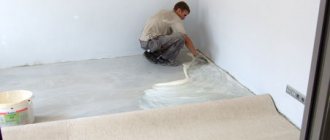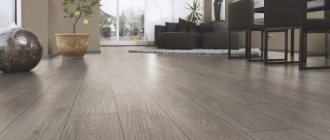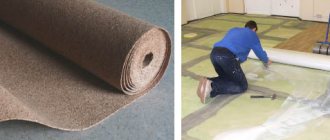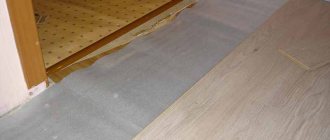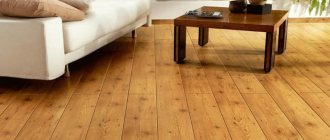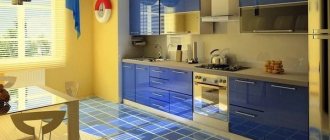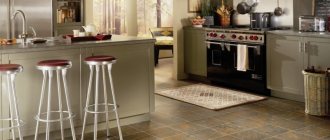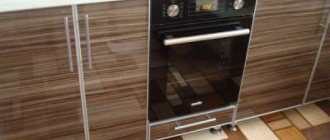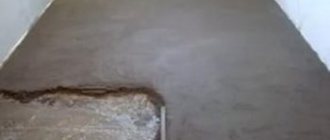Laying a new linoleum covering is always a hassle and problems with glue and alignment of the canvas; you not only have to monitor the joining of the pattern and the parallelism of the edges. Plus, you need to be able to properly smooth out the waves on the linoleum on the floor, otherwise the material, after laying and setting the adhesive base, will turn into an accordion.
After storage curled, it will be difficult to straighten the fabric
Features of linoleum deformation
From time immemorial, the basis of the canvas has been and remains polyvinyl chloride. As the formulation developed, softeners and plasticizers were added to it, but the PVC base remained even in the most modern models of homogeneous and heterogeneous types. The polymer has excellent decorative and performance qualities; it is easy to spread and smooth on the floor before installation.
Everything would be fine if not for a couple of problems associated with the technology of its production and storage:
- The hot PVC sheet is rolled out on rollers, a pattern and varnish are applied, cooled and rolled into a roll with a diameter of several tens of centimeters. Finally, the material “freezes” in a folded state, so there are always waves on new linoleum, which are difficult to smooth out, but still possible;
- It is worse if the linoleum covering was stored rolled up for a long time. The facial layers stretch, and on the back side they shrink and thicken. Such a fabric could be smoothed out if PVC, like any plastic, did not age.
“Dried”, having lost most of the plasticizer, linoleum turns from a plastic and soft floor covering into something like cardboard.
Advice! It is almost impossible to smooth out or remove waves on linoleum if several years have passed since installation. Even if heated or rolled on a flat surface.
Therefore, having purchased a new linoleum covering, you should at least try to roll out and quickly smooth out the linoleum. This is usually done before installation; the material is laid out on a flat surface for several days or even a week. Before sticking, the panel can be rolled up for a short time into a roll or “book”. A slight deformation of the canvas in a short time does not lead to the appearance of waves.
Popular types of linoleum
Household linoleum collection Classic, Triumph 112, width 1.5 m. Komitex Lin
Household linoleum from the Classic collection is a floor covering that gives the interior a unique appearance. Natural textures of wood, marble tiles and cork will make your living space comfortable and cozy. The collection includes popular design solutions that can bring any of your ideas to life. The classic is made of high-quality materials and not only has an attractive appearance, but is also a practical solution for your floor.
Household linoleum Classic collection, Tver 631, width 1.5 m. Komitex Lin
Household linoleum collection Venus Taco 3214, width 2 m. Juteks (Yuteks)
A distinctive feature of linoleum is that it is very easy to install. Linoleum is used in residential and work areas. In domestic conditions it is used in living rooms, corridors, bedrooms, kitchens, etc. Depending on the scope of application, linoleum may have a different protective layer (chemical composition and thickness).
Household linoleum has a smaller protective layer than semi-commercial linoleum, etc. Also, the presence of different linden substrates determines the scope of the most optimal use of linoleum. The widespread use of linoleum is due to the combination of low price with high consumer characteristics, ease of installation and a rich variety of different patterns.
READ MORE: Do-it-yourself linoleum laying technology step-by-step guide
Household linoleum Voyage collection, Tiana 2157, width 2.5 m. Ideal
Collection of Voyage linoleums from the manufacturer Ideal - household linoleums with a thickness of 3 mm and a protective layer of 0.25 mm. There are patterns like wood, stone parquet and tiles. These linoleums are attractive not only in design, but also in price. Semi-commercial linoleum is the best PVC flooring solution. A middle ground between commercial household linoleum, it takes the best qualities of these types of flooring.
Semi-commercial linoleum collection Start, River 6387, width 2.5 m. Ideal
The launch of the manufacturer Ideal is a collection of semi-commercial linoleums that reliably serve in public spaces, as well as in various parts of the apartment with high traffic. The presence of a certificate allows us to recommend the Start collection for use in domestic premises.
Household linoleum collection Glory, Rustic Blok 7008, width 3.5 m. Ideal
The Glory collection linoleums have interesting designs, and the reasonable price will allow you to give the interior an extraordinary style.
Semi-commercial linoleum is the best PVC flooring solution. A middle ground between commercial and household linoleum, it takes the best qualities of these types of flooring. Strong resistance to damage, long service life and ease of use and installation make it suitable not only for various small firms and government enterprises, but also for private use. The coating has a combination of decorative properties and durability.
Commercial homogeneous linoleum collection IQ Optima 42864, width 2 m. Tarkett (Tarkett)
Commercial homogeneous linoleum is mainly suitable for public spaces. It is indispensable in healthcare and educational institutions, as its advantage is hygiene and safety. Tarkett linoleum consists of a homogeneous layer and the design structure is identical from surface to base.
The surface of linoleum requires regular maintenance: cleaning and applying special mastics. If you follow proper care, the service life can reach more than 25 years. IQ Optima linoleum is a durable and low-maintenance floor covering for public spaces. The collection is made unique by special 3D design effects.
Why did linoleum go in waves?
If the floor covering turned out to be fairly new and, after purchase, was laid on the floor according to all the rules, with exposure and smoothing, then the problems, as a rule, end there.
Older linoleums, especially multi-layer ones or with an additional wear-resistant layer, almost always produce waves. Even if the linoleum was rolled and leveled, waves would still appear. The reason for this behavior of the material is as follows:
- Different layers of fabric in a twisted coating are stretched or deformed by different amounts;
- During storage, some of the layers stretched or contracted with the appearance of residual deformations.
Wave on a waterlogged wooden base
If you simply unroll the canvas and leave it in the hope that the material will return to normal under its own weight, then, most likely, you will not be able to smooth out the plastic, since the layers are deformed beyond the critical norm. The use of PVC has certain advantages; it is known that vinyl fabric in a plastic, slightly heated state can be stretched with an elongation of up to 10%. Due to thermal expansion, a standard vinyl linoleum sheet can change dimensions by 0.5% or 1 cm for every 5 m of the sheet. This is not much, but quite enough to smooth and straighten the linoleum from the waves. You just need to heat the material correctly.
Therefore, you should not panic if you were unable to level the linoleum from the waves after purchase. New material can always be smoothed out with a little ingenuity and using available tools
Installation errors
The reason for the appearance of waves on the surface of the floor covering can also be violations of the installation technology. For example, excessive haste when laying linoleum. In the classic version, the linoleum coating is laid on a solid base, the glue is applied in strips at a distance of 60-70 cm. If you try to stick it solidly, the surface will have to be smoothed and rolled with a heavy construction roller for a couple more hours.
The skating rink allows you to smooth out the most stubborn waves
If this is not done, then bubbles and waves with residual adhesive mass will certainly remain. Some of the defects disappear due to shrinkage of the glue, but if you do not straighten the linoleum from the waves before the adhesive mass hardens, then bumps and humps will appear on the floor surface. After such gluing, it will become impossible to remove the bumps on the linoleum.
Sometimes craftsmen simply make mistakes when stretching the linoleum, and then whole folds appear, which also need to be dealt with. You have to lift the edge of the linoleum and re-glue the canvas. If there are no other ways to smooth the surface, then you have to cut the material.
Important! For gluing linoleum, it is best to use polyurethane and acrylic adhesives. They do not dissolve the material and give minimal shrinkage.
You cannot use polyurethane foam or paints based on nitro or alcohol-containing solvents; in both cases, the linoleum cannot be smoothed out; moreover, the material will shrink seriously. A canvas with a width of 2.5-3.5 m shrinks by 10-15 mm.
Improperly prepared base
In addition to being hard and rigid, the subfloor on which linoleum will be laid must be absolutely insensitive to moisture in any form. Most often, PVC coating is laid on a wooden base and even on planed plank floors. If the surface is not primed and waterproofed, then any attempt to lay the canvas on glue will lead to swelling of the wood and, as a result, stretching of the linoleum itself.
Polyvinyl chloride is not afraid of water, even if the lining is made of porous PVC, its structure will not be damaged. Remaining absorbed water will only contribute to the rotting of the wooden base of the floors. Some of the glue will be squeezed out into the cracks, and after the wooden base has dried, the PVC panel will be in a loose state, bubbles and folds will appear on the surface. It is quite possible to smooth out such linoleum, but it is probably easier to use a primer.
On what basis
Even when choosing a floor covering, the question arises of what to lay linoleum on. Is it necessary to prepare the foundation and, if so, how seriously? The answer is simple: linoleum can be laid on any base. The main thing is that it is smooth, durable and clean. Preparation takes place and can be easy and quick if the base is level. In this case, the floor is simply cleaned and dried. If the floor has potholes or large uneven surfaces, preparation takes longer. For correction, screed or self-leveling mixtures can be used; dry screed with sheet building material (plywood, OSB, MDF boards) is also used. It all depends on the type of base.
You can lay linoleum yourself
Concrete and wood floor
You can easily lay linoleum on a concrete floor. In general, there may be differences on the surface, the main thing is that they are not local - small and deep pits and tubercles are excluded. There may be changes, but they are smooth. If there are significant unevennesses, it is better to fill in a leveling screed before laying linoleum.
Linoleum lays on a flat concrete floor without any problems
This finishing coating is also laid on a flat wooden floor. Many people think that the wood will rot underneath it. If the wood is dry, without signs of infection with fungi and mold, then nothing will happen to it. When laid correctly, a sealed layer is obtained, so that moisture does not penetrate inside. If there are seams, they are welded so that moisture penetration into them is unlikely. To prevent water from getting under the baseboards, choose wide models and press them well to the floor. A more reliable way is to lay self-adhesive tape under the linoleum along the perimeter for sealing.
If the boardwalk itself is made correctly, with normal ventilation, then there is no reason for it to rot. If you are very worried, before laying linoleum, treat the floor with antiseptics.
If there are noticeable cracks in the plank floor, they will be visible on the flooring after some time. If they are small, they can be puttied and the surface can be leveled using sanding. Sometimes the floorboards arch, lifting slightly at the edges. It will not be possible to sand such a floor - there are a lot of nails. In this case, or if the gaps are too large, it is recommended to put sheet material on top of the boards - plywood, OSB, MDF
They are good because they do not have very high thermal expansion, and OSB does not yet absorb moisture (you can take moisture-resistant plywood), and this is important in wet rooms (in the kitchen, for example)
Before laying linoleum on a wooden floor, it is better to level it with plywood or OSB
Chipboard and fiberboard as a base for linoleum are not a very good option - when humidity increases, they swell, and the fiberboard goes in waves. After drying, the original shape is not restored, so the linoleum laid on top becomes hunched and wrinkled.
Before laying linoleum, you need to lay OSB or plywood. This is necessary if the plank floor “plays” and the boards sag. If you lay the coating directly on the boards, it will crack in the places where it bends, and quite quickly. This means replacing the floor covering, and problems with the boards are also possible - moisture can seep into the cracks.
This is what it means “with seams running apart”
When laying any sheet material to level the floor under linoleum, it is laid with the seams staggered so that they do not coincide (like brickwork). Small seams are left between the sheets, which are then filled with elastic (non-hardening) mastic.
Is it possible to lay new linoleum on the old flooring?
Let’s say right away that before laying linoleum, it is advisable to remove the old coating. But this can be problematic and then it is permissible to lay flooring on top of an existing one. This is true only if the old floor is smooth or unevenness can be repaired. New linoleum is laid on the old floor, on tiles, on parquet. If there are defects in the base - chips, dents, protrusions - they are eliminated, sealed with putty, trimmed, the seams between the tiles are rubbed down so that the surface is even.
Lay linoleum on parquet, tiles or other linoleum. But only under one condition - the base must be level
There are usually no problems with old linoleum as a substrate. If there are bumps, they are pierced, filled with glue, and the cracks are coated with a repair compound - cold welding for type “C” linoleum or sealant. When laying new linoleum on old one, there may be another problem - it will turn out too soft and significant depressions may form under the legs of the furniture.
On parquet, as well as on plank floors, it is advisable to lay a backing made of sheet material - the planks can also “walk”, tearing the coating.
How to smooth linoleum on the floor
The way to correct the situation is selected depending on the severity of the situation. It is known that PVC polymer can be leveled using:
- The pressure of oppression or a load laid on top of the linoleum panel;
- Impregnation with special reagents;
- Exposure to high temperature.
Important! In addition, you need to take into account the air temperature in the apartment. If you lay the material before the start of the heating season, then as the floor warms up you will have to find a way to smooth out small waves.
It is known from practice that linoleum begins to shrink under load, so small waves can disappear on their own. This rule applies to old homogeneous brands of coating; modern imported materials practically do not shrink.
It is clear that the best effect is obtained by combining and simultaneous use of all three methods. But it is better to refrain from trying to smooth linoleum with chemicals, although it is known that a piece of fabric soaked in an alcohol-acetone mixture, placed under a wave or bubble, can smooth linoleum better than any professional. True, this seriously increases the risk of irreversibly damaging the canvas.
How to remove waves on linoleum
The simplest and safest way to smooth out the resulting ridge is to weld the wave to the base of the floor. To do this, at a minimum, you need to heat the material.
But first of all, you need to try to “drive” the area with the wave to a less noticeable place, for example, under furniture. This is possible if the material is glued to the base in strips. You should not try to remove the wave on the linoleum in the middle of the room. Firstly, if you fail, there will be a stain that will be difficult to hide. Secondly, heating can cause darkening or deformation of the swelling area of the linoleum.
We try to drive out and smooth out the wave towards the edge of the material
The elimination technology is quite simple. It is necessary to heat a section of linoleum with a wave for a long time so that not only the coating, but also the rough base is heated. It is best to try to smooth out the defect with an iron. Any will do, preferably without a steam function, but with a temperature regulator. You can take an old cast iron iron, heated on a gas burner. The heavier the tool, the better.
Linoleum cannot be heated directly. The softening temperature of PVC starts at 85°C. The soleplate of an electric iron heats up within 140-250°C, depending on the mode. A gas iron can get hotter. Any attempt to directly smooth the linoleum on the floor after bending will end in the melting of the polymer coating.
Warming up with gluing
Therefore, they heat the wave in several ways:
- Through thick cotton fabric or tarpaulin;
- Through a pillow filled with quartz sand;
- Through aluminum foil and fabric.
The problem is that you not only need to heat it, but also press the linoleum to the base. In this way, it is possible to compact the coating material so much that it becomes harder and more rigid. Some of the PVC fills the cracks and joints, but in any case, after cooling the wave disappears.
You can try to smooth out the linoleum on the floor with a hairdryer; to do this, lay thin aluminum foil over the damage. The heating side of the foil is wiped with silicone oil so that the metal does not stick to the PVC; it needs to be heated for 7-10 minutes.
To smooth the comb, after heating, leave the hot cloth and additionally load it with pressure. The plastic under the load is left to cool for at least 5-8 hours. One way to remove waves on linoleum is shown in the video:
Often you have to open the bubble to remove the glue and smooth out the linoleum
How to remove bubbles on linoleum
The procedure for eliminating blisters on an already laid coating looks more complicated. The presence of a bubble means that there is air remaining under the vinyl sheet, and since the damage does not change its position, the air plug has nowhere to go. There are two ways to eliminate the problem and smooth the fabric, but first, poke a hole in the center of the bubble with a needle and feed a small amount of PVA-M into it.
In the first case, you can heat the bubble with a hair dryer or iron, moving towards the center in a spiral. Next, to smooth out the swelling, it is covered with a cloth and allowed to cool for an hour.
The second method is more complicated; in the center, after the air has escaped, the linoleum is cut with a rosette and glued with heat to the base. If done carefully, there will be no traces left. You can also remove a bubble on linoleum, as in the video:
The effect is the same.
The glue is easy to inject with a syringe
How to remove creases on linoleum
Removing a broken canvas is complicated by the fact that it is impossible to glue or smooth it to the rough base. As a rule, you have to remove the baseboard and peel off the fabric from the nearest wall to the crease. At the point of intersection with the baseboard, the linoleum is cut with a sharp knife to remove the overlap and trim off excess material.
After that, PVA glue is applied under the linoleum, carefully rolled with a roller and heated for several minutes.
If problems arise during operation
Due to the fact that linoleum is made from PVC, the properties of this material depend on operating conditions. In particular, over time, various defects may appear on the floor covering due to insufficient heating of the room. In the cold, PVC loses its former elasticity. In addition to the above reasons, mistakes made during the installation process lead to swelling of linoleum:
- installation on an uneven base;
- use of low-quality glue;
- laying on a base without adhesive;
- installation on a damp base.
It is recommended to lay this flooring on a special base (cork or other), which reduces the likelihood of the described defects occurring.
Installation was carried out without the use of glue
Laying floor coverings without glue is permitted in rooms whose area does not exceed 20 square meters. In this case, it is necessary not only to level the material before installation, but also to secure the linoleum tightly against the walls using a plinth. In larger rooms, the covering is laid on an adhesive solution.
If the installation was carried out without observing the specified conditions, and swellings appeared on the floor, then to eliminate the defects you need to perform the following steps:
- remove the covering by dismantling the baseboards;
- using a long stick or other means (roller, etc.) to level the material;
- if necessary, trim the linoleum near the walls;
- place heavy objects on the fractures and keep them in this form until the defects disappear.
After this, it is necessary to re-lay the material, gluing the base.
The coating has been glued
If, as part of installation, the material was glued to the “sub-floor”, then the described methods can be used to eliminate defects.
How to level linoleum before laying
A standard situation occurs when the material is stored in a roll on the balcony to remove the unpleasant odor. After unrolling the panel over the base, it becomes clear that waves appeared due to the fact that the linoleum was twisted.
Huge folds can run across the entire surface; heating them with an iron or hairdryer is pointless; it will take a long time, and the material will become hard, like cardboard. Therefore, the unfolded cloth must be carefully spread on the floor, and can be heated with an infrared heater. The main thing is that the load is laid and evenly distributed on the surface. These could be things or even just stacks of books, bags of building materials or sports equipment. Every two or three days the pressure is rearranged, after a week the linoleum can be finally smoothed with a roller.
Before laying the canvas, it is not enough to smooth it out; it needs to take the shape of the floor surface.
Operating rules
To prevent linoleum from losing its original properties, the following operating rules must be observed:
- avoid direct exposure to sunlight;
- maintain a comfortable indoor temperature;
- do not carry heavy objects on the surface of the material, including furniture on wheels;
- remove water and wet fabrics from the surface of the coating in a timely manner;
- immediately remove aggressive substances from the surface;
- Avoid contact with sharp objects and abrasive substances.
See also
How to beautifully paint a case with your own hands, ideas and step-by-step instructions
It is also important to promptly seal the resulting holes. To do this, you need to cut out a small part of the linoleum at the location of the defect and seal it with a new piece.
Advice from professionals
In order not to get into trouble with the flooring, you need to pay attention to the linoleum markings. For home flooring, they are usually taken with the designations P2 - plastic, tensile, C2 - resistant to household chemicals and water.
Commercial and semi-commercial brands are very difficult to smooth out, so they need to be rolled into a large diameter roll and purchased immediately before installation.
In any case, before trying to lay the material, you can cut a thin strip, heat it with a hairdryer and check how much the PVC stretches, and whether the polymer can be smoothed with a roller.
What you need to consider when installing linoleum: main mistakes
In order to lay the flooring efficiently, the technological requirements must be strictly followed. There is no need to rush to complete the work. If the adhesive method of fixing the canvas is chosen, the composition must be applied in increments of 60-70 cm. If the glue is applied continuously, you will have to smooth the canvas for a long time, pressing it with a heavy construction roller. If this is not done, you can expect waves and bubbles to appear.
PHOTO: i.pinimg.com Marking must be done correctly
The size of the decorative fabric to be laid must fully correspond to the area of the base. Excess material will lead to the formation of characteristic folds.
PHOTO: b-online.ru The composition of the glue must be suitable
Special attention should be paid to the quality of foundation preparation. If the subfloor is a subfloor, it should be primed and waterproofed to prevent the wood from swelling when exposed to moisture.
Watch the video to learn how to lay linoleum on an uneven floor:
Watch this video on YouTube
